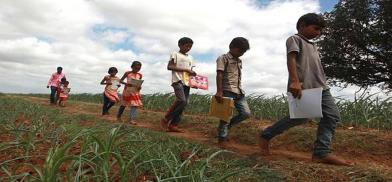Inclusive elementary education: RTE still seen as charity, not a right
Educational inequality in India widened during the pandemic with children from disadvantaged sections dropping out of school due to the digital divide, writes Manab Singha

The National Education Policy (NEP) became India’s first education policy of the 21st century. While we move towards improvements in our education policies, let’s look at the legislative provision, the Right to Education Act (RTE), which was passed over a decade ago. Under RTE 12(1) (c), unaided private schools have the responsibility to reserve 25 percent of seats to provide free education to children (between 6-14 years) from economically disadvantaged backgrounds.
Despite the mandated seat reservation, trends indicate that the upper ceiling hasn’t been met, and only a small percentage of eligible children are taking advantage of the scheme. This number has significantly dropped since March 2020.
The Department of Education has established a model where private schools are reimbursed for these students’ school fees, books and stationery. In July 2021, the Association of Managements of Schools of Karnataka wrote a letter to the Principal Secretary of the Education Department demanding a release of RTE 12(1) (c) funds, noting that the government has been inconsistent in its payments even in the past. The Department responded that payments had been delayed due to the pandemic.
A lack of transparency in the admissions process has contributed to the negative and flawed perception of school authorities that RTE is a charity and not a right. In reality, the Act resides in the belief that equality, social justice and democracy can be achieved only through the provision of inclusive elementary education to all.
Unfortunately, a large portion of eligible families lack awareness about RTE and are often unable to produce the required documents, and thus lose out on admission. Some schools and institutions are also reluctant to provide admissions to eligible students, and often sideline them after they have been admitted. The cumulative effect of these challenges is significant and presents itself as a roadblock to the successful implementation of the RTE Act.
New challenges
The educational inequality in India widened during the pandemic, with concerns about children from disadvantaged sections dropping out of school due to the digital divide. Even in pre-pandemic times, these children faced a multitude of issues, including discrimination from school authorities and peers, which led to social isolation, hindered socio-emotional development and ultimately school dropouts.
Even after a decade since the Act came into force, states have been unable to set up a competent system of execution. Hundred percent allocation of RTE seats to the eligible students is still not being explored in states due to lack of uniformity in seat allocation, lack of mechanisms to monitor student performance and, lastly, ambiguity and lack of trust among schools and the Central and state governments about the reimbursement process.
A recent Indus Action Report brings forth some startling figures and gaps in the implementation of RTE.
Till 2020, 33 states/UTs had notified the eligibility criteria for weaker sections and disadvantaged groups for admissions in private unaided schools under the Act, with Telangana being the only applicable state which had not done so. However, of these 33 states, only 17 States/UTs were admitting children under the Act.
The pandemic also has caused delays in the RTE admission process in most states.
Recommendations
The convergence of different line departments of the state government such as Panchayat Raj Departments and the Women and Child Development Departments can raise mass awareness through on-ground functionaries. Engagement with community-based organizations, setting up technology interventions, and bringing transparency to the RTE admissions process is the need of the hour. There are several successful models that can be easily replicated.
In Chhattisgarh, Indus Action’s 3-year programme has culminated in the enrolment of over 2 lakh children and a handover process with district-level departments also started in 2021.
In Odisha, creating an online process for RTE admissions has secured 36,000 RTE seats for children from vulnerable groups.
In Uttarakhand too, Indus Action has achieved the ‘Ten Thousand Mark’ of RTE admissions.
Another solution is building an efficient system at the state level so that the state and central budgetary contribution can be mobilized efficiently to meet the on-ground needs. Scaling up the skills of government officials needed for such interventions is essential.
Some examples
There’s a need for taking a leaf out of some noteworthy examples of Public-Private Partnerships for RTE implementation in India and deploying similar initiatives. A couple of examples are:
Indus Action and Cisco India’s Project “Eklavya supported the Act’s implementation in 2017-19 in Uttar Pradesh, Gujarat and Maharashtra through on-ground campaigns and MIS Consultancy for the government to implement the RTE Act with greater transparency and efficiency.
A 2018 partnership between Indus Action and Mission Taleem involved setting up 100 application desks around 12 centers in New Delhi for socio-economically weaker families to claim their children’s right to education.
While the government has been successful in getting more children to school, the progress has not been linear across the country. Even as efforts are being made to address these issues plaguing India’s education sector, creating awareness about RTE and changing perceptions about this fundamental right is key to getting the ball rolling in the right direction.
(The author is a Project Management Unit Lead, Chhattisgarh and East Zone, Indus Action. Views are personal.)









Post a Comment